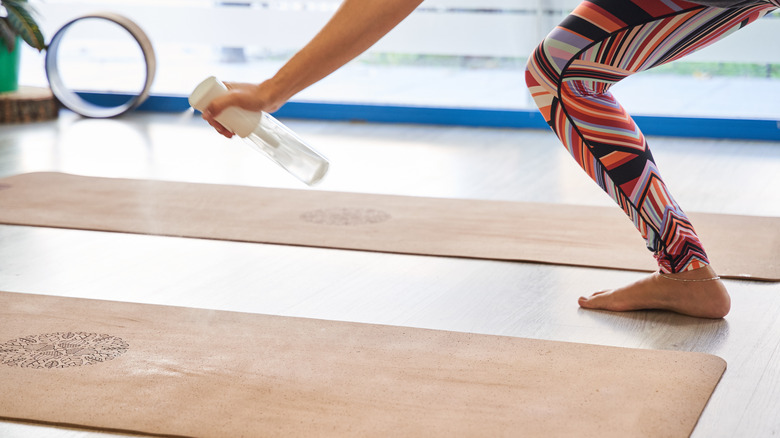The Secret To Breaking In A Slippery Yoga Mat
Yoga mats do more than provide you with a cushion to practice on. They're also essential for you to have stability during your yoga journey. Without them, you could fall out of a pose and possibly injure yourself. However, a big problem comes with purchasing a new mat. Depending on the material you choose, it may be slippery. This sounds counterintuitive since one of the main reasons you bought the mat is to have extra traction while doing yoga.
Disrupt Sports explains that PVC mats are most likely to be slippery when you first purchase them. Fortunately, you can practice yoga safely on these types of mats once the top layer is eroded away, which happens on its own after some time. But waiting for this to happen isn't the best option. You don't want to risk falling and having the wrong posture in the meantime, when you can speed up the process and use a perfect mat from the beginning. Luckily, there are many ways to take off the top layer with items you already own.
Use a degreaser
A degreaser is perfect for cutting through that top slippery layer on your new yoga mat. There are a few different everyday household products that will work with this method. Mixing a solution of distilled white vinegar and water is one option, or you could dilute mild detergents like dish soap. If you don't have any of these cleansers, you can even use shampoo, according to Yoga Shop.
Add the degreaser of your choice to a spray bottle and cover your entire mat with it. Then use a damp sponge to scrub it. Next, rinse all the soap suds off, making sure there's no residue left on the mat. The best way to dry your yoga mat is by rolling it up in a towel and squeezing it to remove the leftover water. Then you should hang it to completely dry in an area away from direct sunlight.
Scrub with sea salt
Another efficient way to remove the top layer from your yoga mat is by scrubbing it with sea salt. The more course the salt is, the better. Yogigo explains that this is one of the most effective methods since it physically scrubs the problematic layer off. It's also eco-friendly since you're using salt instead of other sprays. It'll work best on mats made out of plastic. You shouldn't do it on natural materials like jute and microfiber because it will damage them.
You only need a handful of sea salt for this way to work. Sprinkle it across your mat, so it's evenly covered. Then use a wet cloth to scrub the salt into the top layer. Be careful not to push too hard, or you can accidentally damage it. To get the most out of this method, go over spots where you frequently come into contact with the mat so they have even more grip.


